
scrounge: /skrounj/ informal verb: to actively seek [books] from any available source
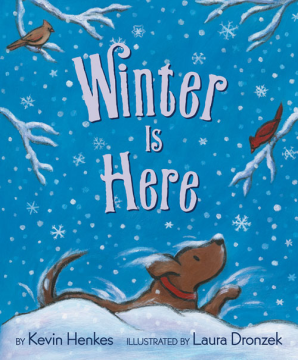
I'm so glad Kevin Henkes has taken to writing about the seasons, and I hope he does all of them. Winter Is Here is a poetic exploration of the sights and feelings of winter -- from the way the snow covers the outside world to the many different articles of clothing that a child must put on before going out to play. Gentle text works well for young children, and the bright illustrations bring colors and definition even to descriptions of white snow and transparent ice.
Of course, the best part of this book is that it ends with spring!
Scrounged From: Our local library
Format: Hardcover
Author: Kevin Henkes
Illustrator: Laura Dronzek
Pages: 40
Content Advisory: None
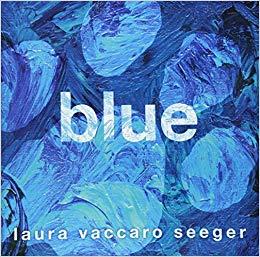
I enjoyed Laura Seeger's exploration of the color green in Green (see my review here), and I thought Blue was just as well done -- illustrations consisting of textured paintings, including cut-outs on each page that become something different when the page is turned. The text also follows the same pattern, describing (with occasional rhymes) different kinds of blue as displayed on each colorful double page.
This particular book is different in that it has a theme -- it follows the story of a boy and his dog, and thus illustrates even the feeling of "blue" as the boy eventually mourns the aging and loss of his friend. This is very simply communicated through the pictures and spare text, and will certainly tug at the heart-strings of any dog-lover. I'm not much of a "dog person" myself, but I can still appreciate the friendship portrayed here, and how adequately the feeling of loss can be summed up with just a color.
I think it would be wonderful to see a picture book like this for many more colors!
Scrounged From: Our local library
Format: Hardcover
Author/Illustrator: Laura Vaccaro Seeger
Pages: 40
Content Advisory: None
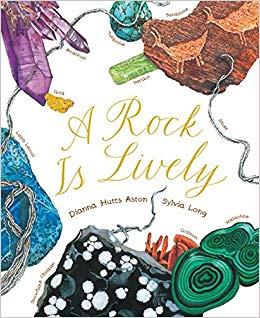
I can't say that "lively" would be my first choice for "best words to describe rocks," but I also wouldn't have considered the pyramids of Giza in the same thought as comets either, yet both are neatly contained within this succinct exploration of rocks.
I really love this series. A Rock Is Lively takes us on a journey to discover and ponder the scope of rocks, from sandy beaches to asteroids. Like A Seed Is Sleepy (see my review here), the variety here is impressive and awe-inspiring, without being overwhelming. The illustrations are gorgeous, capturing the colors and sparkles of gems as well as the numerous earth tones of more "ordinary" rocks.
We learn about the rock cycle, what rocks are made of, where we can find rocks, and some of the things rocks are used for -- from tools for animals and people, to use as art and weapons throughout history. Phrases like "A rock is inventive..." are the only places I'd consider that this diverges a bit from strict nonfiction, but that's forgiveable because the poetic descriptions add a lot to this book and make it a bit more "lively" than your average geology book. I really love that this series makes topics like this interesting and accessible to small children, but also teaches us older people a thing or two, even if it's just to say "Wow!"
Scrounged From: A Christmas present
Format: Paperback
Author: Dianna Hutts Aston
Illustrator: Sylvia Long
Pages: 40
Content Advisory: None
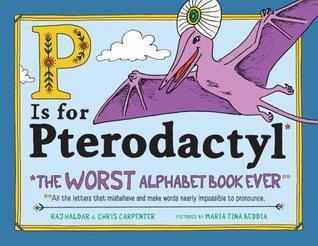
I thought P Is for Pterodactyl: The Worst Alphabet Book Ever looked like an amusing book when I first saw it, so I was glad I got it for Christmas last month. It'll make a great conversation piece, and as a proofreader I'm all too familiar with the difficulty that certain English words give us (myself included) -- we have plenty of exceptions to our language rules!
I was indeed amused while reading this, and found it a fun way to collect a good percentage of silent consonants in one place. Probably this wouldn't appeal to children until they were old enough to be reading some of these more difficult English words, but it could also be useful for someone who's learning English as an adult.
In some ways this alphabet book isn't consistent, because not every letter is used as a silent first letter the way P is (as in "Ptolemy the psychic pterodactyl struggles with psoriasis"), but that's understandable. For many letters, the text instead focuses on silent letters in other parts of words (such as the "n" in "hymn" and "autumn" or the "z" in "rendezvous"). Sometimes the book simply points out what a letter is not for, as in "F is not for photo, phlegm, phooey, or phone." Occasionally it "cheats" a little and focuses on words that are more clearly from other languages (J is for Jai Alai, a sport of Basque origin).
But despite the fact that I think it "reaches" for a few of these, the premise is funny and it does a good job collecting so many weird words with silent letters. At the end is a glossary, which is helpful because I've always wondered how "gnocchi" was pronounced, plus it includes an explanation for why "ptero" got the "p" in the first place.
Scrounged From: A Christmas present from my brother
Format: Hardcover
Authors: Raj Haldar and Chris Carpenter
Illustrator: Maria Beddia
Pages: 32
Content Advisory: None
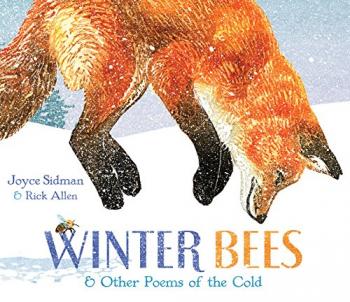
Winter Bees is a wonderful picture book of Joyce Sidman's poetry, especially fitting for those who live in a cold climate like we do. Have you ever wondered where bees go in the winter? Or voles, or beavers? This book contains a double-page spread on each featured piece of nature (mostly animals), containing a poem and then a few paragraphs of information about how the animal gets through winter, which helps to fill out the information in the poem.
The poetry here is lovely, and full of clever descriptive phrases. Most poems are of moderate length, managing to communicate a clear picture of winter survival without becoming repetitive or overly wordy.
Bees are "an ancient tribe, a hardy scrum... Together, we boil, we teem, we hum."
Snoflakes are "a lattice of stars spinning silently..."
A raven is a "Squawker, Croaker, Alarm-on-the-wind."
The poem about beavers is written as a pantoum, a poetry form that I don't remember encountering before, featuring some neat repetition of lines.
The illustrations here are amazing -- colorful, full of texture and life. I especially love how a long picture of a branch is drawn as moving from autumn to winter at the beginning of the book, and then again at the end it is shown morphing from winter into spring.
Scrounged From: Our local library
Format: Hardcover
Author: Joyce Sidman
Illustrator: Rick Allen
Pages: 32
Content Advisory: None


